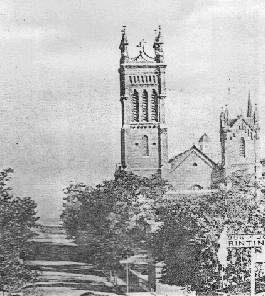
Our History
The first beginnings of the Shrine of the Immaculate Conception, the oldest Catholic church in north Georgia and Atlanta’s first Catholic Church, are told in stories of early missionaries to the area. No existing records prior to 1846 verify when or where the first Mass was celebrated in Atlanta. Conflicting stories from that period suggest various private homes or a school building as the site of that first Atlanta liturgy.


In all probability missionary priests were ministering to Atlanta by the early 1840’s. These early missionary priests followed the railroad, celebrating Mass in various railroad camps and towns throughout north Georgia.
In his book History of the Diocesan Shrine of the Immaculate Conception, Van Buren Colley includes the following as missionary priests who served Atlanta Catholics on a monthly basis, the Fathers: Jeremiah F. O’Neill, Jr.; John Brady and Gregory Duggan of Augusta; John Francis Shannahan of Macon; Jeremiah F. O’ Neill, Sr. of Savannah (an uncle of Fr. J.F. O’ Neill, Jr.); and Fr. Birmingham of Edgefield, SC. (Colley, pg. 9) Fr. Shannahan is credited by some sources with founding the Mission of Atlanta, but no written record confirms this.
Atlanta Catholics completed their first church building in 1848. Not yet named, it was known simply as “the Catholic Church”. This building stood on the same site as the present Shrine of the Immaculate Conception. This first church was a simple wood frame structure similar to the construction of surrounding buildings.
Behind the altar of their new church, the parishioners hung a reproduction oil painting of Murillo’s “Immaculate Conception”. Anecdotal evidence states that this painting was chosen because of the special devotion to the Blessed Mother held by these early Atlanta Catholics. The building was dedicated in 1849 by the Right Reverend Ignatius A.Reynolds, bishop of the Diocese of Charleston.



It is not known which priest directed the building of this first Catholic Church in Atlanta (and the first in north Georgia ). Fr. John Barry was the missionary priest assigned to the city during the years of church construction, but it is likely that Fr. John Francis Shannahan may also have been involved.
In 1850 the state of Georgia was made a diocese in its own right. Spiritual direction of Atlanta ’s Catholics passed from the Diocese of Charleston to the Diocese of Savannah. Bishop Francis X. Gartland was the first bishop of the Savannah Diocese.
In 1851 Fr. Jeremiah F. O’Neill, Jr. became the first priest to be officially assigned to Atlanta. A wealthy railroad official, Terrance Doonan, petitioned the Right Reverend F.X. Gartland to assign a resident priest to the city of Atlanta. Mr. Doonan offered to pay all expenses associated with the posting as well as all living expenses of the priest. Accepting Mr. Doonan’s offer, Bishop Gartland appointed Fr. O’Neill as pastor. The Atlanta Catholic Church thus became a parish rather than a mission.
The original church was constructed of wood on the corner of Lloyd Street and Hunter Street now known as Central Avenue and Martin Luther King, Jr. Drive in 1848 by an Irish missionary, Father John Barry. It was dedicated and named Church of the Immaculate Conception in early 1849 by Bishop Ignatius A. Reynolds of Charleston.
According to Van Buren Colley, others who subsequently served as pastors of the Atlanta Catholic Church from 1851 until the church’s dedication as Immaculate Conception Church in 1873 include:
Fathers J.F. O’Neill, Sr.; James Hasson; P.J. O’ Keefe; Thomas O’Reilly; M. Cullinan (as administrator); H.P. Clavreul; John McCarthy; Terrance Scollan; William Quinlan; and John B. Duggan. (Colley, pg. 19)
From 1850 through the next decade both Atlanta and the Atlanta Catholic Church continued to grow rapidly. Cotton production and new commerce brought an increase in immigration to the area, a large portion of which was of the Catholic faith. The Atlanta Catholic Church, recently a mission church herself, by 1860 now supported several mission churches of her own.


